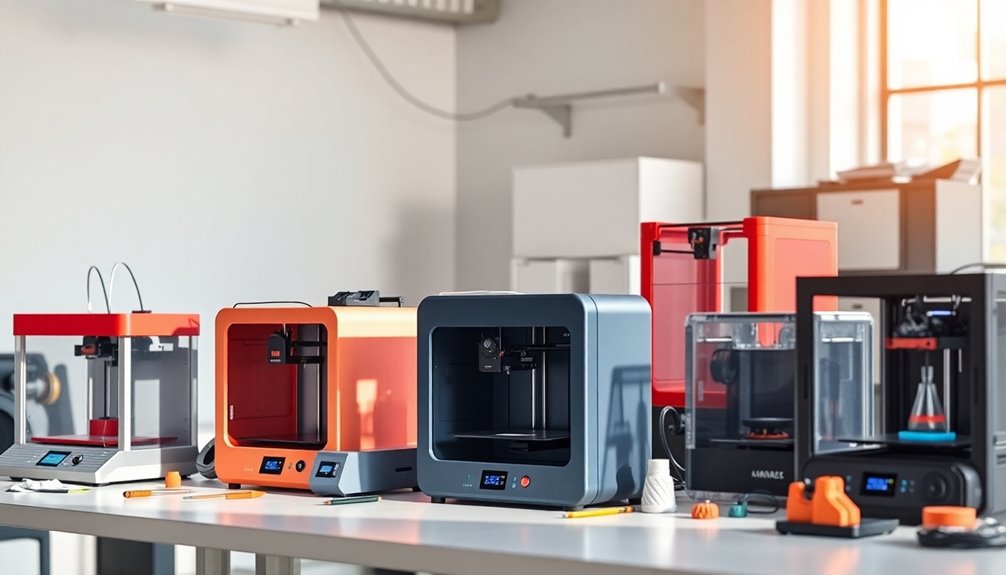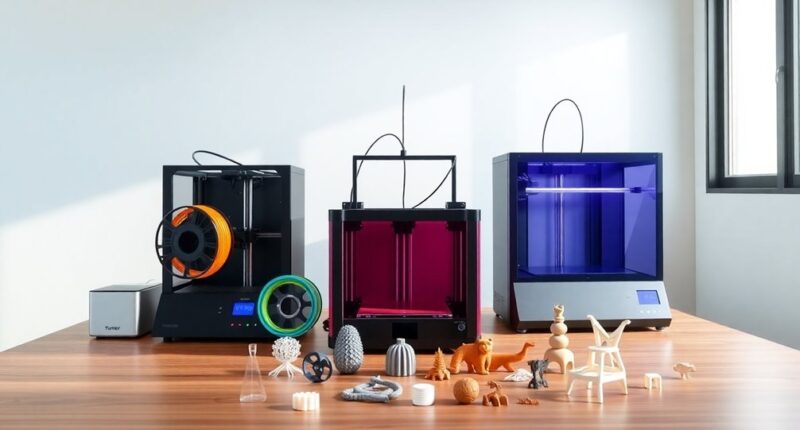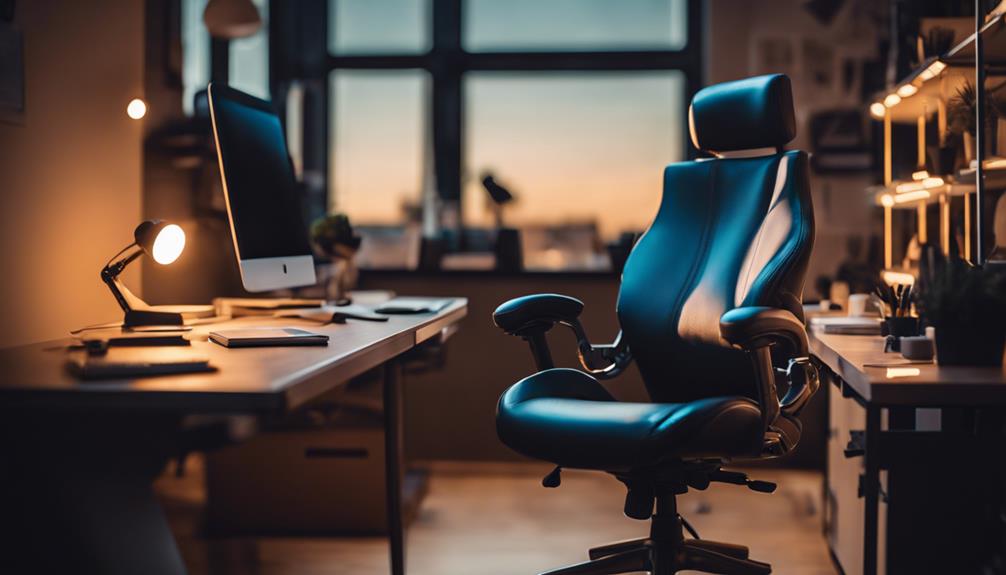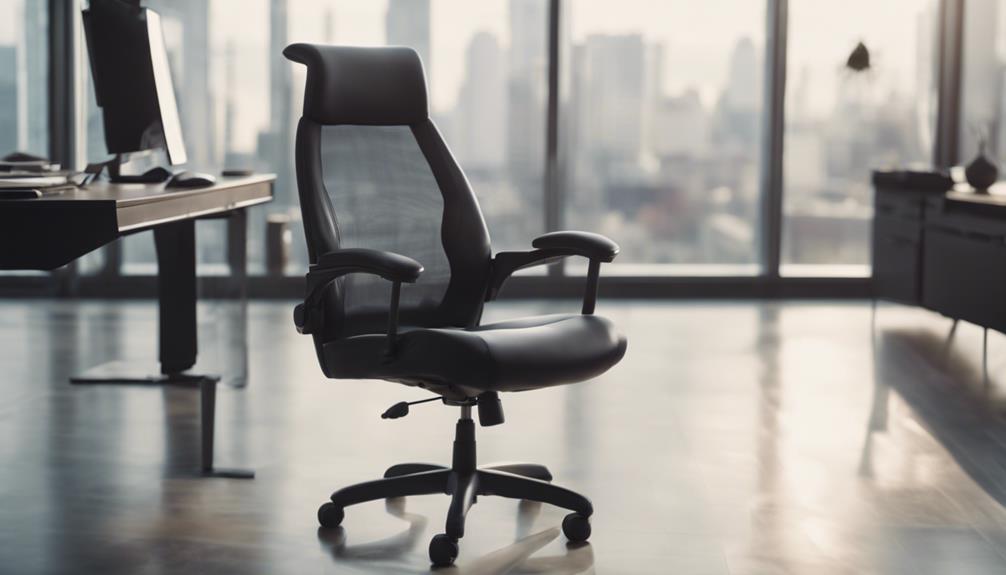Looking for the best 3D printers of 2025? I've got you covered! From the Creality 3D Printer K1 SE, perfect for kids and beginners, to high-performance models like the Creality K1 Max Upgraded, there's something for every budget and skill level. The FLASHFORGE Adventurer 5M impresses with its auto-leveling feature, while the Creality K2 Plus Combo offers multi-color printing. If you're curious about which printer suits your needs best, keep reading for more insights!
Key Takeaways
- Top 3D printers cater to various budgets, ranging from entry-level models for beginners to high-performance options for professionals.
- Key user needs include easy setup, reliability, speed, and versatile filament compatibility for diverse projects.
- Popular choices like Creality K1 SE and FLASHFORGE Adventurer 5M excel in user-friendliness, making them ideal for kids and beginners.
- Advanced features such as automatic leveling and real-time monitoring enhance usability and print quality for all skill levels.
- Consideration of maintenance needs and support resources is vital for ensuring long-term performance and satisfaction with your 3D printer.
Creality 3D Printer K1 SE for Kids and Beginners
If you're a parent or a beginner enthusiastic to plunge into the world of 3D printing, the Creality 3D Printer K1 SE stands out as an excellent choice. It's fully assembled and ready to go in about three minutes, which is a huge plus for busy schedules. With a print speed of 600mm/s, it handles various filaments like PLA and TPU effortlessly. While many users rave about its user-friendly setup, I've noticed some challenges with print bed adhesion. Overall, it's an exciting option that encourages creativity and learning, making it perfect for kids and beginners keen to explore 3D printing.
Best For: The Creality 3D Printer K1 SE is best for kids and beginners who are eager to explore the world of 3D printing with a user-friendly and easy-to-set-up machine.
Pros:
- Fully assembled and ready to use in approximately 3 minutes, making it ideal for busy users.
- Capable of high print speeds (600mm/s) and can handle various filament types, including PLA and TPU.
- Provides a supportive after-sales service with 24/7 customer assistance and a 1-year warranty.
Cons:
- Some users have experienced issues with print bed adhesion, affecting print quality.
- Occasional challenges with setup and functionality, including motherboard-related problems.
- Users have reported mixed experiences regarding achieving a high-quality surface finish, often requiring slower print speeds.
Creality K1 Max Upgraded 3D Printer
For anyone looking to plunge into the world of 3D printing, the Creality K1 Max Upgraded 3D Printer stands out with its impressive maximum speed of 600mm/s and advanced AI monitoring features. With a generous print size of 300×300×300mm, I can tackle multiple models at once. The smart AI LiDAR scans the first layer, pausing if it detects issues, which gives me peace of mind. Setup is a breeze thanks to automatic bed leveling. While I had to tweak some settings for peak performance, I've been thrilled with the print quality and reliability. Overall, it's a fantastic choice for both beginners and experienced users.
Best For: The Creality K1 Max Upgraded 3D Printer is best for beginners and experienced users looking for a high-speed, reliable 3D printing experience with smart features.
Pros:
- Fast printing speed of 600mm/s allows for quick model production.
- Smart AI LiDAR and monitoring features enhance print reliability and quality.
- Automatic bed leveling simplifies setup, making it user-friendly for newcomers.
Cons:
- Some users may need to adjust settings for optimal performance, which can require a learning curve.
- Issues with filament changes and extruder performance may necessitate upgrades.
- Delivery issues reported by some users, although not related to the product itself.
FLASHFORGE Adventurer 5M 3D Printer
The FLASHFORGE Adventurer 5M 3D Printer stands out with its fully automatic leveling feature, making it an excellent choice for beginners and hobbyists alike. Its impressive print speed of 600mm/s and high-flow nozzle guarantee quick, high-quality results. The 220x220x220mm print size is perfect for various projects, while the dual-fan system enhances print quality across materials. I love the convenience of one-click automatic printing and remote monitoring through the Flash Maker app. Although some users face filament feeding issues and a bit of noise, this printer remains a fantastic entry point into the world of 3D printing.
Best For: Beginners and hobbyists seeking an easy-to-use, reliable 3D printer with advanced features.
Pros:
- Fully automatic leveling for hassle-free setup and operation.
- Impressive print speed of 600mm/s ensures quick project turnaround.
- Remote monitoring via the Flash Maker app allows for real-time adjustments.
Cons:
- Limited variety of slicing software, primarily requiring proprietary tools.
- Reports of filament feeding issues and extruder performance challenges.
- Loud operation compared to other 3D printer models.
Creality K2 Plus Combo 3D Printer
Creality K2 Plus Combo 3D Printer stands out with its impressive capability for multi-color printing, making it ideal for creators who want to produce vibrant and intricate designs. With a maximum printing speed of 600mm/s and a generous build volume of 350mm³, I found it perfect for tackling larger projects. The next-gen direct drive extruder and dual AI cameras really enhance the printing experience, providing real-time monitoring and ensuring quality. While some users faced issues with delivery and assembly, once set up, it delivers exceptional performance. Overall, I believe it's a solid choice for both novice and experienced users.
Best For: Creators looking to produce vibrant, multi-colored designs with a reliable and high-speed 3D printer.
Pros:
- Impressive multi-color printing capabilities with up to 16 colors.
- High maximum printing speed of 600mm/s and a spacious build volume of 350 x 350 x 350mm.
- Equipped with dual AI cameras for real-time monitoring and automated error detection.
Cons:
- Some users report issues with delivery and assembly quality.
- Difficulties in reaching customer support can lead to frustration.
- Inconsistent assembly quality can affect overall printer performance.
FLASHFORGE Adventurer 5M 3D Printer
If you're looking for a powerful yet user-friendly option in 3D printing, the FLASHFORGE Adventurer 5M stands out with its impressive max speed of 600mm/s and rapid heating capabilities. I found the Core XY all-metal structure incredibly efficient, and the built-in vibration compensation guaranteed smoother prints. The dual-sided PEI platform made model removal a breeze. Setting it up took me about 20 minutes, and the included SD card was a great touch for quick first prints. After a few years of use, the reliability has been fantastic, and I even trust it for creating functional parts that really hold up.
Best For: The FLASHFORGE Adventurer 5M 3D Printer is best for hobbyists and professionals who seek a reliable, efficient, and user-friendly 3D printing experience.
Pros:
- Easy assembly and operation with clear instructions and setup videos.
- High-speed printing capabilities with advanced features like vibration compensation and dual-sided PEI platform for effortless model removal.
- Long-term reliability demonstrated by creating sturdy functional parts, making it suitable for various applications.
Cons:
- Initial setup may require time for bed leveling, which could be challenging for beginners.
- Some users may experience issues with specific materials like PLA if not adjusted properly.
- The dual nozzle feature is not frequently utilized, limiting its versatility for users who may want to explore dual-material printing.
Creality Ender 3 V2 Upgraded 3D Printer
Looking for a reliable and user-friendly 3D printer? The Creality Ender 3 V2 Upgraded is an excellent choice. With a build volume of 8.66 x 8.66 x 9.84 inches, it handles projects with ease. I love its silent motherboard, which keeps noise to a minimum while printing. The carborundum glass platform guarantees great adhesion, and if there's a power outage, the resume function saves my work seamlessly. Assembly might require some effort, but following YouTube tutorials makes it manageable. Plus, it's compatible with PLA filament, making it perfect for beginners wanting high-quality prints without hassle.
Best For: Beginners looking for an affordable, high-quality 3D printer that is user-friendly and reliable.
Pros:
- Silent operation due to the enhanced motherboard, providing a quieter printing experience.
- Resume printing function effectively saves progress during power outages, minimizing waste.
- Easy assembly with accessible online tutorials, making it manageable for first-time users.
Cons:
- Requires self-assembly, which may be daunting for some users without prior experience.
- Calibration is essential and can be time-consuming to ensure optimal performance.
- Limited to PLA filament for best results, which may restrict material options for advanced projects.
QIDI PLUS4 3D Printer
The QIDI PLUS4 3D Printer stands out for its impressive print speed of 600mm/s, making it an ideal choice for both professionals and beginners who crave efficiency in their projects. With a spacious print size of 12 x 12 x 11 inches, it accommodates various filaments like ABS and PET. The second-generation active chamber heating system reduces warping, ensuring high-quality prints. I love the quick setup, allowing me to unbox and print within 10 minutes. Plus, the remote monitoring via the QIDI app is a game-changer. Overall, this printer delivers excellent performance and versatility for all my 3D printing needs.
Best For: Professionals and beginners looking for a high-speed, versatile 3D printer that delivers quality and efficiency in various filament types.
Pros:
- High printing speed of 600mm/s enhances productivity for larger projects.
- Second-generation active chamber heating system minimizes warping and improves print quality.
- User-friendly interface with quick setup and remote monitoring capabilities.
Cons:
- Some users report noise levels being higher than expected during operation.
- The rear-mounted filament dry box design may be inconvenient for some setups.
- Occasional complaints about filament loading process can lead to frustration.
3D Printer for Kids, Beginner 3D Printer with 8 PLA Filament Set
For young aspiring creators, the D Printer for Kids stands out as an ideal choice, especially with its smart app control that makes 3D printing accessible and fun. It's designed for kids aged 8-10, so setup and operation are a breeze. With high precision and speeds up to 200 mm/s, I love how it brings ideas to life quickly. Plus, the built-in camera allows real-time monitoring. While there are some minor app issues, I found the vast library of over 1,500 designs and 8 PLA filaments to be fantastic for creative exploration. It's a great introduction to 3D printing!
Best For: This product is best for young aspiring creators aged 8-10 who want to explore the world of 3D printing in a fun and accessible way.
Pros:
- Easy setup and operation designed specifically for kids, making it user-friendly.
- Access to a vast library of over 1,500 digital designs and weekly updates for endless creativity.
- Built-in camera for real-time monitoring and time-lapse video generation enhances the printing experience.
Cons:
- Frequent clogging of the printer nozzle reported by some users can disrupt the printing process.
- Heating element issues occurring after multiple prints may require troubleshooting.
- App functionality problems experienced by users, suggesting a preference for using a computer program instead.
QIDI MAX3 High-Speed 3D Printer
Engineered for speed and precision, the QIDI MAX3 High-Speed 3D Printer stands out as an ideal choice for makers and designers who demand exceptional performance. With a printing speed of 600mm/s and a spacious build volume of 325×325×315mm, it handles intricate designs effortlessly. The CoreXY structure and Klipper firmware guarantee reliability, while its compatibility with a range of filaments, including carbon fiber composites, expands creative possibilities. I appreciate its quiet operation and easy setup, though I recommend good ventilation during use. Plus, Qidi's responsive customer support enhances the overall experience. You won't be disappointed with this high-performance machine!
Best For: Makers and designers seeking high-speed, high-precision 3D printing capabilities with versatile material compatibility.
Pros:
- High printing speed of 600mm/s allows for rapid prototyping.
- Compatible with a wide range of materials, including specialty filaments like carbon fiber composites.
- Excellent customer support with quick response times and proactive issue resolution.
Cons:
- Air filtration system is not HEPA certified, requiring good ventilation during use.
- Some manufacturing flaws noted, although they have been addressed by customer support.
- Setup instructions may need updates for clarity, despite the overall easy setup process.
Creality K1C 3D Printer (2024 New Version)
Offering remarkable speed and precision, the Creality K1C 3D Printer (2024 New Version) stands out as an ideal choice for enthusiasts and professionals alike who demand high-quality prints without sacrificing time. With a max speed of 600mm/s and 12X faster performance than standard printers, it's a game-changer. The clog-free direct extruder and tri-metal unicorn nozzle make it compatible with various high-temp materials. I love the hands-free auto-calibration and AI camera for real-time monitoring. Plus, its silent mode guarantees a peaceful workspace. Overall, the K1C combines advanced features with user-friendly operation, making it a fantastic investment for any 3D printing enthusiast.
Best For: The Creality K1C 3D Printer is best for 3D printing enthusiasts and professionals seeking high-speed, high-quality prints with user-friendly features.
Pros:
- High-Speed Performance: Achieves a maximum speed of 600mm/s, making it 12X faster than standard printers.
- Advanced Features: Includes hands-free auto-calibration, an AI camera for monitoring, and silent operation for a peaceful workspace.
- Material Compatibility: Supports a wide range of high-temp materials thanks to the clog-free direct extruder and tri-metal unicorn nozzle.
Cons:
- Mixed Reliability Feedback: Some users have reported issues with long-term reliability, including nozzle temperature fluctuations.
- Noise Issues: A few users have noted noise concerns, despite the printer's silent mode feature.
- Documentation Gaps: The need for more comprehensive manuals in multiple languages has been highlighted for better user guidance.
Tina2S 3D Printer with WiFi Cloud Printing for Beginners and Kids
Designed specifically for beginners and kids, the Tina2S 3D Printer stands out with its fully assembled setup, making it incredibly easy to start printing right out of the box. You get an SD card loaded with models and an intuitive app that supports various printing methods. I love its automatic leveling and heated spring steel build plate, which guarantees high-quality prints. Plus, the upgraded WiFi module lets me transfer files quickly. Although it's compact, it produces detailed prints effortlessly. For anyone hesitant about 3D printing, the Tina2S offers a reliable and enjoyable experience, perfect for diving into this creative world.
Best For: The Tina2S 3D Printer is best for beginners, kids, and arts and crafts enthusiasts looking for an easy-to-use, compact 3D printing solution.
Pros:
- Fully assembled and ready to use out of the box, making setup a breeze.
- High precision and quality prints, often achieving flawless results on the first attempt.
- User-friendly app and responsive customer support enhance the overall experience.
Cons:
- Small filament holder may require careful management of filament rolls.
- Some users reported issues with the WiFi printing feature and screen freezing.
- Lacks advanced features like a heated bed and filament presence sensors, which may limit some users.
ELEGOO Neptune 3 Pro FDM 3D Printer
The ELEGOO Neptune 3 Pro FDM 3D Printer is an excellent choice for hobbyists and beginners who want to plunge into the world of 3D printing without the hassle of complicated setup processes. With a spacious build volume of 225x225x280mm, it handles various filaments like PLA and ABS effortlessly. The dual-gear direct extruder and efficient cooling system guarantee high-quality prints with minimal clogging. I appreciate its auto bed leveling feature, which simplifies calibration. Plus, it's quiet, operating at just 47-48 dB. Overall, this printer delivers reliability and performance, making it a fantastic option for anyone starting their 3D printing journey.
Best For: Beginners and hobbyists looking for an easy-to-use, reliable 3D printer with good print quality and a spacious build volume.
Pros:
- User-friendly setup with pre-assembled components and simple navigation.
- High-quality prints with a variety of filaments due to the efficient dual-gear direct extruder and cooling system.
- Quiet operation at 47-48 dB, making it suitable for home or office environments.
Cons:
- Requires manual bed leveling and nozzle height adjustment before each print.
- Some users may experience difficulties with delicate prints or specific models.
- Limited advanced features compared to more expensive professional printers.
FLASHFORGE Adventurer 5M 3D Printer
If you're looking for a 3D printer that balances ease of use with advanced features, the FLASHFORGE Adventurer 5M could be your perfect match. It's designed for both beginners and experts, featuring a one-click leveling system that simplifies setup. I appreciate the all-metal Core XY structure, which delivers impressive printing speeds of up to 600mm/s. While the touchscreen can be finicky, the quick-detachable nozzles make maintenance a breeze. However, I'd suggest being cautious with customer support experiences. Overall, it's a solid choice if you're ready to explore its capabilities while maneuvering a few minor hiccups.
Best For: The FLASHFORGE Adventurer 5M is best for both beginner and experienced 3D printing enthusiasts looking for a user-friendly printer with advanced capabilities.
Pros:
- Fully automatic one-click leveling system simplifies setup for new users.
- High-speed printing capabilities of up to 600mm/s with excellent print quality.
- Quick-detachable nozzles allow for easy maintenance and fast swaps.
Cons:
- Customer support experiences can be inconsistent and slow.
- Touchscreen interface can be finicky, requiring multiple taps for responsiveness.
- Some users reported issues with the build plate and extruding plastic quality.
TINA2 Mini 3D Printer for Beginners
Perfect for beginners and kids, the TINA2 Mini 3D Printer stands out with its fully assembled design and user-friendly 2.4" LCD display. I love how easy it is to set up, making it perfect for my 10-year-old grandson. It comes with sample PLA filament and a Micro SD card filled with model files. The auto bed leveling feature guarantees precise printing, and if there's a power outage, it resumes effortlessly. With a compact design and a flexible build plate, it's simple to store and use. Overall, it delivers great print quality and reliable performance, making it a fantastic choice!
Best For: The TINA2 Mini 3D Printer is best for beginners and kids looking for an easy-to-use and reliable 3D printing experience.
Pros:
- User-friendly setup with a clear 2.4" LCD display.
- Compact design allows for easy storage and portability.
- Good print quality and stable performance with various filament types.
Cons:
- Some users may experience a learning curve with slicing software.
- Occasional minor printing issues like off-center prints may occur.
- Limited build size may not accommodate larger projects.
Creality K1C 3D Printer (2024 New Version)
For those seeking speed and efficiency in 3D printing, the Creality K1C 3D Printer (2024 New Version) stands out with its impressive printing speed of 600mm/s, making it twelve times faster than standard models. With a generous build volume of 8.66 x 8.66 x 9.84 inches, it supports various filaments, including carbon fiber. I love how user-friendly it is—it's plug and play within minutes! The auto calibration features simplify setup, and the AI camera guarantees real-time monitoring. While I've heard about some nozzle inconsistencies, upgrades can enhance performance, making this printer a solid choice for enthusiasts and professionals alike.
Best For: The Creality K1C 3D Printer is best for speed-focused 3D printing enthusiasts and professionals looking for high-quality outputs in a short time frame.
Pros:
- Impressive printing speed of 600mm/s, significantly reducing production time.
- User-friendly setup with auto calibration features, allowing for quick and easy operation.
- Versatile filament compatibility, including carbon fiber, broadening creative possibilities.
Cons:
- Reported nozzle inconsistencies from the factory may affect initial print quality.
- Potential need for upgrades such as dual Z-axis kits for optimal performance.
- Learning curve for new users, despite available resources and community support.
Factors to Consider When Choosing 3D Printers

When I'm choosing a 3D printer, I think about several key factors that can make a big difference. Printing speed and quality, filament compatibility, and the size of the build volume all play an essential role in my decision. Plus, I always consider how user-friendly the setup process is and what maintenance or upgrades might be needed down the line.
Printing Speed and Quality
While balancing printing speed and quality might seem challenging, it's essential for anyone looking to invest in a 3D printer. Many modern printers can reach speeds up to 600mm/s, dramatically cutting down print time. However, achieving high-quality prints involves more than just speed; it's about fine details and smooth surfaces. Factors like nozzle diameter and layer height play significant roles here. The printer's acceleration—up to 20000mm/s² in advanced models—also affects how quickly it can change direction while printing. Features such as automatic bed leveling help guarantee the first layer adheres properly, preventing issues like warping. Ultimately, finding the right balance between speed and quality is key to getting the results you want.
Filament Compatibility Options
Choosing the right 3D printer requires careful consideration of filament compatibility, as it directly impacts the types of projects you can tackle. I always look for printers that can handle a broad range of filaments, from standard options like PLA and ABS to advanced materials like nylon and carbon fiber. If I plan to use specialty filaments, I make sure the printer has a high-temperature nozzle that can reach 300°C or more. The extruder design is also key—direct drive extruders typically perform better with flexible filaments. Additionally, features like a heated print bed or enclosed chamber can greatly improve adhesion and reduce warping, especially for materials like ABS. Finally, consider if you want multi-material or multi-color capabilities.
User-Friendly Setup Process
A smooth setup process can make all the difference in your 3D printing experience, especially if you're just starting out. I recommend looking for printers that come fully assembled or require minimal setup time—ideally between 3 to 30 minutes. Features like automatic bed leveling can simplify initial adjustments, while plug-and-play functionality lets you dive right into printing after unboxing. User-friendly interfaces, especially those with touchscreens, can make the operation feel more approachable. Plus, having access to extensive setup guides, instructional videos, and responsive customer support can really help you tackle any initial challenges. These factors not only enhance accessibility but also boost your confidence as a newcomer to the world of 3D printing.
Build Volume Size
When it comes to 3D printers, build volume size plays a crucial role in determining what you can create. Fundamentally, it refers to the maximum space within which your printer can produce an object, typically measured in millimeters. If you're looking to print larger models or multiple smaller items at once, a larger build volume offers more versatility. For instance, a printer with a build volume of 250x220x220mm is great for medium-sized prints, while one with a 300x300x300mm can handle larger designs. Think about your intended use; if you're a hobbyist, a bigger volume might be ideal for intricate projects. Just verify your designs fit within the printer's capacity to avoid failed prints or resizing headaches.
Maintenance and Upgrades
While many factors influence your experience with a 3D printer, maintenance and upgrades are essential for peak performance. I've found that regular maintenance checks, like ensuring screw tightness and bed stability, can notably improve print quality and prevent wobble. Upgrading components such as the extruder or adding dual Z-axis kits can really enhance performance, especially for high-quality prints. Don't forget to dry your filament before use; moisture can lead to clogging and poor results. Also, watch for nozzle size inconsistencies from the factory, as they can affect your prints. Finally, utilizing community resources and tutorials can guide you through these processes, making your 3D printing journey smoother and more enjoyable.
Support and Resources Available
Choosing the right 3D printer involves more than just specifications; it's crucial to evaluate the support and resources available. Many printers come with a 1-year limited warranty, which gives me peace of mind for any potential issues. Plus, 24/7 customer support is a huge bonus—dedicated teams are there to help with troubleshooting and technical questions. I've found that extensive online resources, like user manuals, forums, and tutorial videos, make steering through setup and maintenance much easier, especially for newcomers. Community-driven platforms allow users to share tips and solutions, enhancing my overall experience. Finally, access to slicing software and pre-configured profiles simplifies the printing process, so I can focus on my creativity instead of getting bogged down by technical details.
Frequently Asked Questions
What Materials Can I Use With These 3D Printers?
When I think about the materials I can use with 3D printers, it's exciting! I've experimented with PLA, which is user-friendly and biodegradable. ABS is another favorite of mine for its durability, though it requires a bit more care. I've also dabbled in PETG for its strength and flexibility. If I'm feeling adventurous, I've even tried specialty filaments like wood-infused and metal-infused options. The possibilities are really endless!
How Long Does It Take to Print a Model?
When I print a model, the time it takes can vary widely. It often depends on the complexity and size of the design. For simple, small items, it might only take a couple of hours. However, larger or more intricate models can take several hours or even days. I've learned to plan ahead and factor in print time, especially for projects with tight deadlines or specific timeliness. Patience really pays off!
Are There Safety Concerns for Children Using 3D Printers?
Absolutely, there are safety concerns for children using 3D printers. I've noticed that the machines can get quite hot, and there's a risk of burns. Plus, inhaling fumes from the melted plastic can be harmful. It's essential to supervise kids closely and guarantee they wear proper protective gear. I always recommend setting up the printer in a well-ventilated area and teaching kids about safety protocols to keep their experience fun and safe.
What Maintenance Is Required for 3D Printers?
When it comes to 3D printers, I've found that regular maintenance is essential for keeping them in top shape. I clean the nozzle and bed frequently to prevent clogs and guarantee good adhesion. I also check the belts and rails for tension and lubrication, which helps maintain precision. Occasionally, I update the firmware to improve functionality. By staying on top of these tasks, I can keep my printer running smoothly and efficiently.
Can I Upgrade My 3D Printer in the Future?
Absolutely, you can upgrade your 3D printer in the future! I've done it myself, and it's a rewarding experience. Many printers allow for modifications like new nozzles, hotends, or even firmware upgrades. Just make sure to research compatibility before diving in. I've found that upgrading not only enhances performance but also extends the printer's lifespan. So, if you're considering it, go for it—you won't regret it!
Conclusion
As we wrap up our journey through the world of 3D printers, it's clear that each option is like a unique brushstroke on the canvas of creativity. Whether you're a budding artist or a seasoned pro, there's a perfect fit waiting for you. Immerse yourself in the domain of possibilities, and let your imagination take flight. Remember, the right 3D printer can transform your ideas from mere whispers into vibrant realities. Happy printing!









